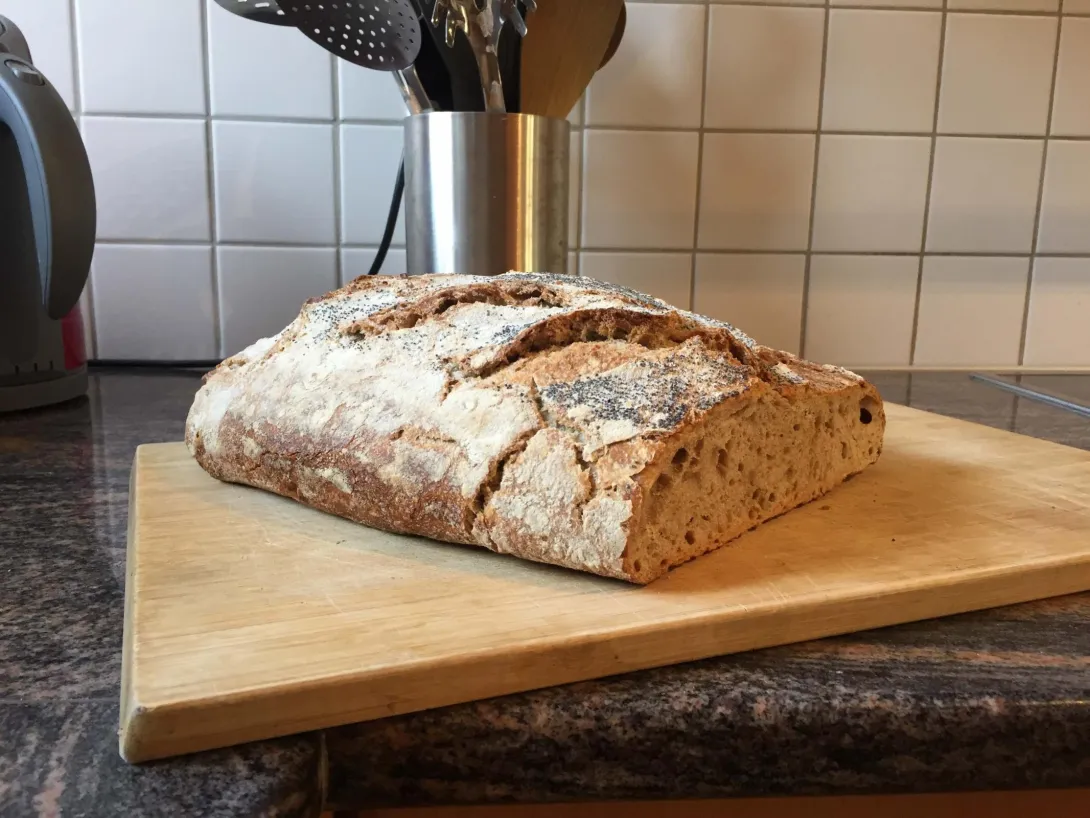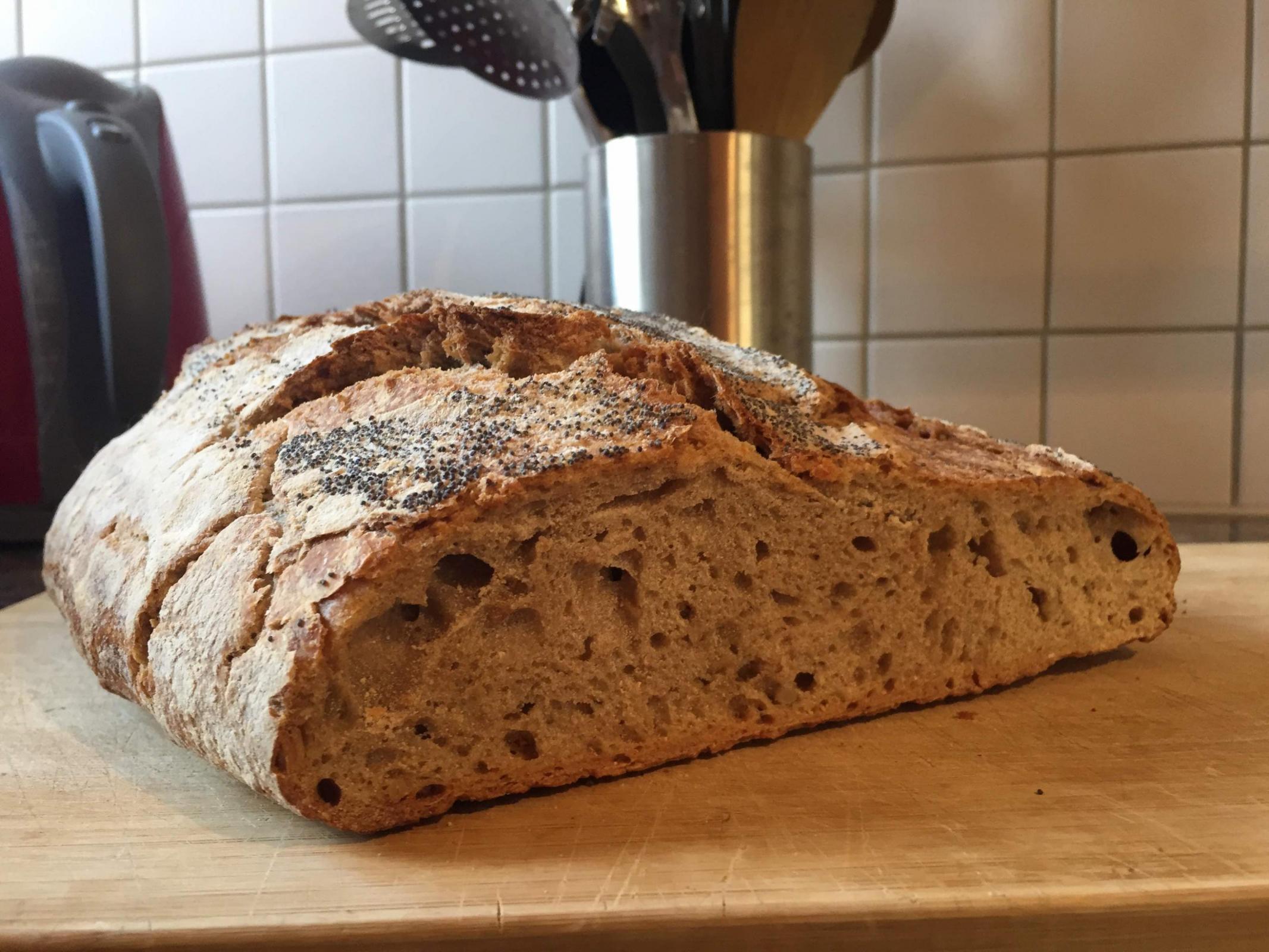Hi,
I recently decided to challenge myself by giving up my Römertopf (or Oblong clay pot) and decided to use some kind of rectangular Dutch oven like this one in order to bake my batard-shaped sourdough breads :
https://www.cdiscount.com/pdt2/3/5/6/1/1200x1200/auc4020728511356/rw/cocotte-rectangle-rubis-stoneline.jpg
(I use it upside down such that the lid gives me a large flat surface)
Where I can easily fit 2 kg of dough in the shape of a batard.
The issue being that now, I have nothing that retains my doughs from flattening out after putting it straight from the banneton on the lid of the dutch oven. I then put the lid and cook for the first 50 minutes with the lid on but when I remove it, I always end up finding some kind of flat pancake (Photo below), that remains delicious but which he's nothing from the likes of the previous batards I would bake in my Romertopf claypot. My hydration level is usually between 68 and 72% and I proceed the following :
Mixing : 1kg of flour (200g of whole wheat, 300g of white flour and 500g of semi whole-wheat flour, what we call here bise flour), 200g of double sized sourdough started (fed with 100g of rye flour and 100g of water), 20g of salt and hence 680g approx. of water.
Then every 30 minutes after mixing, I do a set of Stretch and Folds. After 2 hours of Bulk fermentation and 3 S&F, I leave my dough for about an hour at room temp (round 22°C), then preshape, shape tightly (in the likes of King Arthur) and then put it in a large oblong 26cm banneton.
After 8 to 24 hours of proofing in the fridge (7°C), I put it in my preheated dutch oven and that's where's the rub, the dough flattens during the first minutes of baking, ending up like a flying saucer.
Any idea what I am doing wrong, is it the tension that is not good enough or maybe the fermentation process that isn't long enough ? My cooking vessel ? Or maybe even the flour content that is too "whole", though I doubt it's the issue since plenty bakers in the surroundings (Switzerland) are able to come up with brilliant loaves with 100% bise/semi whole wheat flour.
Anyway, some help would be great.
Greetings from Switzerland and thanks in advance.

Hello! I can't comment too much on other parts of your process, but I can say with 100% certainty that your dough is WILDLY underfermented during the bulk stage, and so will not expand much in the oven and will not have enough internal gas pressure to hold shape.
The amount of pre-fermented flour in your recipe clocks in at 9%, and you are fermenting at a room temp of 22C and not bakery temps of 25C+. Under these conditions, I would expect bulk fermentation to take upwards of 6 hours depending on how active your starter is and what your final dough temperature (FDT) after mixing is. At 3 hours, you're barely halfway into the process.
You have many possible variables to address your underfermentation problem--time, temperature, amount of prefermented flour (starter % in recipe). I would suggest tweaking them one at a time, until you arrive somewhere you like. If temperature is not something you can easily control, start by simply allowing the dough to rise in a volumetric container until it has increased in volume by AT LEAST 50% and try to shape, retard and bake again. Good luck!
Thanks for your answer :)
Do you think it would be possible to finish the last 3 hours of BF in the fridge (for like 7-8 hours) instead of 3 at Room Temp ?
So I adressed this problem and your were definitely right, the dough felt much more smooth and swollen as I shaped it.
However, it still flattend considerably in the oven after a 15 hours proofing episode in the fridge, after which the dough was slightly bulging from the banneton.
It seems like it's lacking tension, I only performed 3 S&F and one coil fold every 30 minutes at the beginning of the BF.
Should I consider kneading my dough at the beginning of the BF ? Or maybe autolyse ?
Thanks in advance !
I think I've seen this before.
You are using a North American formula, and handling procedures, with European flours.
EU flours, with their lower protein, generally require more autolyse (pre-soak actually, since it is without levain) and physical kneading (via hand or mixer) than do North American flours.
North American recipes of the "stretch and fold" variety, such as Tartine and FWSY, rely on using North American grown flours.
Your clay baker, with the raised sides, was a "crutch" or "cover up" for the mismatch between your formula and your flours. The flatter and wider dutch oven then shows the deficiency of the mismatch.
If my guess is correct, then the advice that user mariana gave to user bijection05 in this post may help you:
https://www.thefreshloaf.com/node/67524/loaf-cracking-outside-score
Bon chance, mon ami.
I had the same issue recently with a cinnamon raisin batard. As I only have round DO, I tried the baking sheet and inverted aluminum foil pan method that seemed to work for others. My loaf came out very similar - some spring on one side, and flat on the side with the scoring.
My bread included:
50% WW (autolyse for 3 hours at 100% hydration)
50% bread flour
1/4 tsp active CY
80% total hydration
The dough proofed nicely in the 2nd rise but fell flat during the baking. As original poster and I used WW, would that be the issue?
Thanks in advance!